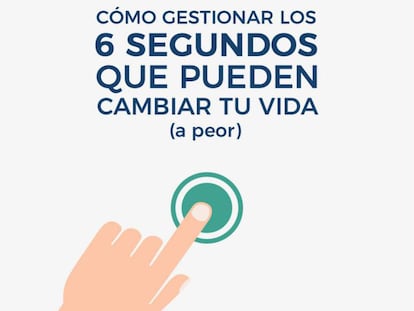How to find opportunities when you are stuck in a career cul-de-sac
Here are the keys to recognizing you are in a work rut and turning it into a learning experience

I met the head of a nursery who left her job to take care of her newborn daughter. She had studied social work and had also trained in economics. After two years off, when she wanted to return to the workforce, she reinvented herself as the community manager for a social network for economists. It was all thanks to that period where she abandoned her “traditional career.” Now she’s her own boss, manages her own time, and is happy with her projects where she can keep growing. This woman is an example of how you can take advantage of dead ends to reinvent yourself.
A particular project may be very desirable – leaving work or taking some time off – but beware it may carry a future price
At some point we all run the risk of getting stuck in a dead-end job, which is something that slows the development of our career. There are many types of dead ends: companies that may not look impressive on a resume, non-strategic departments, time off to take care for children or relatives, and months on sabbatical. Of course, there are times when we have no choice but to make these decisions. Let’s now see what we can do to turn such situations into future opportunities.
First, you need to recognize a dead end. A particular project may be very desirable – leaving work or taking some time off – but beware it may carry a future price. Hiring departments tend to be very traditional and do not always look favorably at resumes that dare to do different things. This doesn’t just happen in labor market: dead ends also exist within companies. You can change departments, but if the new one does not have as much strategic weight, it can lower your chances for a possible promotion. Therefore, if you are at a dead end, the first step is to recognize this so you can start looking for opportunities and doing something new.
Secondly, you need to assume that a dead end is a period of hibernation, not backtracking. Just as hibernating bears continue to maintain basic functions for survival, we can continue to do certain tasks to keep us active in the labor market even if we are not working. Take free courses online from prestigious universities to keep up your skills, maintain your social networks, attend conferences from time to time, and study things that interest you.The objective is to demonstrate that you have been active and you achieved something to prove it. If the dead end is within a large company, continue to maintain contacts with influential people or participate in important projects that offer you visibility. You have to find actions that are a springboard for your future, beyond the work that you do as part of your day-to-day working life.
If you are not working, keep current by studying and maintaining your social networks
Thirdly, you need to assume that certain experiences will make it difficult to return to the point where you left off. When you come back after taking a prolonged break, usually things have changed, either because someone has occupied your position or because you yourself have evolved. Therefore, after periods of absence in a “traditional career,” it is worth taking time to reflect on what you want, what you can contribute to add value and open your range of possibilities. Instead of longing for a position similar to what you had in the past, you can reinvent yourself. Imagine being self-employed, setting up a business or taking part in a project that satisfies you. In other words, you can use the dead end to think and take a turn in your professional career.
In short, we all face complicated decisions in our careers and we can fall consciously or inadvertently into a rut. The idea is not to avoid these, because sometimes it is not possible, but to be aware of what they mean and know how to turn them into opportunities for learning and personal reinvention.
English version by Debora Almeida.
Tu suscripción se está usando en otro dispositivo
¿Quieres añadir otro usuario a tu suscripción?
Si continúas leyendo en este dispositivo, no se podrá leer en el otro.
FlechaTu suscripción se está usando en otro dispositivo y solo puedes acceder a EL PAÍS desde un dispositivo a la vez.
Si quieres compartir tu cuenta, cambia tu suscripción a la modalidad Premium, así podrás añadir otro usuario. Cada uno accederá con su propia cuenta de email, lo que os permitirá personalizar vuestra experiencia en EL PAÍS.
¿Tienes una suscripción de empresa? Accede aquí para contratar más cuentas.
En el caso de no saber quién está usando tu cuenta, te recomendamos cambiar tu contraseña aquí.
Si decides continuar compartiendo tu cuenta, este mensaje se mostrará en tu dispositivo y en el de la otra persona que está usando tu cuenta de forma indefinida, afectando a tu experiencia de lectura. Puedes consultar aquí los términos y condiciones de la suscripción digital.
More information
Archived In
Últimas noticias
Maduro pleads not guilty before the federal court in New York: ‘I am still the president of Venezuela’
A new test can detect Alzheimer’s from a finger prick
UN team enters Sudanese city of El Fasher after paramilitary massacre: ‘It’s like a ghost town’
A recipe for resistance: Indigenous peoples politicize their struggles from the kitchen
Most viewed
- Gilles Lipovetsky: ‘If you want to live better and fall in love, take Prozac, don’t look to philosophy’
- Alain Aspect, Nobel laureate in physics: ‘Einstein was so smart that he would have had to recognize quantum entanglement’
- Alvin Hellerstein, a 92-year-old judge appointed by Bill Clinton, to preside over Maduro’s trial in New York
- Why oil has been at the center of Venezuela-US conflicts for decades
- Cuba confirms death of 32 of its citizens in the US attack against Venezuela










































